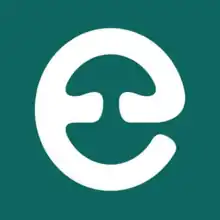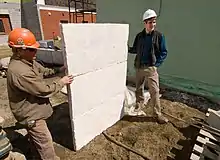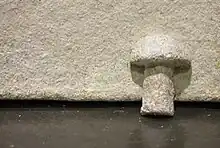Ecovative Design
Ecovative Design LLC is a materials company headquartered in Green Island, New York, that provides sustainable alternatives to plastics and polystyrene foams for packaging, building materials and other applications by using mushroom technology.
 | |
| Type | Private |
|---|---|
| Industry | Biomaterials |
| Founded | 2007 |
| Headquarters | Green Island, New York 42.752685°N 73.694229°W |
Key people | Eben Bayer, Gavin McIntyre |
| Products | MycoComposite, MycoFlex, Atlast |
Number of employees | 45 |
| Website | ecovativedesign |
History
Ecovative was developed from a university project of founders Eben Bayer and Gavin McIntyre. In their Inventor's Studio course at Rensselaer Polytechnic Institute taught by Burt Swersey, Eben and Gavin developed and then patented a method of growing a mushroom-based insulation, initially called Greensulate before founding Ecovative Design in 2007.[1][2] In 2007 they were awarded $16,000 from the National Collegiate Inventors and Innovators Alliance.[3]
Since 2008, when they were awarded $700,000 first place in the Picnic Green Challenge[4] the company has developed and commercialized production of a protective packaging called EcoCradle[5] that is now used by Dell, Puma SE, and Steelcase. In 2010 they were awarded $180,000 from the National Science Foundation[6] and in 2011 the company received investment from 3M New Ventures, The DOEN Foundation, and Rensselaer Polytechnic Institute allowing them to double their current staff of 25.[7]
In spring 2012, Ecovative Design opened a new production facility and announced a partnership with Sealed Air to expand production of the packaging materials.[8][9] In 2014 their material was used in a brick form in 'Hy-Fi', a 40 feet (12 m) tower displayed in New York by the Museum of Modern Art and they started selling 'grow-it-yourself' kits.[10]
In November 2019, the company announced a $10M investment to support their new Mycelium Foundry.[11]
In February 2020, IKEA committed to using Ecovative technology for packaging, replacing polystyrene.[12]
In April 2021, Ecovative Design received a $60M investment to develop new applications for their technology and scale up manufacturing.[13]
Mushroom materials

Mushroom materials are a novel class of renewable bio-material grown from fungal mycelium and low-value non-food agricultural materials using a patented process developed by Ecovative Design. After being left to grow in a former in a dark place for about five days during which time the fungal mycelial network binds the mixture, the resulting light robust organic compostable material can be used within many products, including building materials, thermal insulation panels and protective packaging.[14]
The process uses an agricultural waste product such as cotton hulls, cleaning the material, heating it up, inoculating it to create growth of the fungal mycelium, growing the material for period of about five days, and finally heating it to make the fungus inert.[15] During growth, the material's shape can be molded into various products including protective packaging, building products, apparel, car bumpers, or surfboards. The environmental footprint of the products is minimized through the use of agricultural waste, reliance on natural and non-controlled growth environments, and home compostable final products.[16] The founders' intention is that this technology should replace polystyrene and other petroleum-based products that take many years to decompose, or never do so.[7]
Protective packaging
A renewable and compostable replacement for polystyrene packaging,[17] that is also referred to as 'EcoCradle.[18]
Structural biocomposites
A natural and renewable replacement for engineered wood, formed from compressed mushroom material and requiring no numerical control.[19] Architect David Benjamin of The Living, working with Evovative Design and Arup, built 'Hy-Fi', a temporary 40 feet (12 m) external exhibit at the Museum of Modern Art in New York City in 2014.[20][21]
Thermal insulation
An insulation product is under development.[22] Trials of 'Greensulate', a former product,[23] were conducted at a Vermont school gym in May 2009.[23] The product was later dropped when the company switched focus to the manufacture of protective packaging.
Other uses

Ecovative offer a 'Grow-it-yourself' kit allowing people to create mushroom materials themselves, used to create products including lamp shades.[10]
Working with the University of Aachen, Dutch designer Eric Klarenbeek used 3D printing technology to gown a chair without using plastic, metal or wood.[24]
Media
Popular Science featured the composite insulation in its 2009 Invention Awards.[25] A season six episode of CSI: New York, also featured the insulation as lab technicians tested the materials' flame resistant properties after finding particles on a victim's clothing.[26] Packaging World magazine featured Ecovative on its July 2011 cover, suggesting that the company is poised to "be a game changer in various industries."[27][28] The World Economic Forum also recognized Ecovative as a Technology Pioneer in 2011.[29] Additionally, the founders were featured on the PBS show, Biz Kid$, in episode 209, "The Green Economy & You."[30]
Support
The development of the material and processes has been supported by the Picnic Green Challenge, the Environmental Protection Agency, National Collegiate Inventors and Innovators Alliance (NCIIA), ASME, the National Science Foundation, NYSERDA, 3M New Ventures, The DOEN Foundation, Rensselaer Polytechnic Institute and a license agreement with Sealed Air.[7][31] In addition to an array of awards, Ecovative's materials have been extensively highlighted in Material ConneXion libraries around the world.[32]
References
- Pasko, Jessica (25 June 2007). "Mushrooms are eco-friendly insulation". USA Today. Retrieved 24 July 2012.
- "History". EcovativeDesign.com. Ecovative Design. Archived from the original on 5 May 2012. Retrieved 25 July 2012.
- "NCIIA: Promoting Student Inventors". Bloomburg Businessweek. Archived from the original on 2015-08-16.
- "Amerikaan wint Picnic Green Challenge". Parool.nl. 26 September 2008. Retrieved 24 July 2012.
- Binder, Libuse. "Ecovative Design: Making Magic Out of Mushrooms". Earth 911. Archived from the original on 22 July 2012. Retrieved 24 July 2012.
- "Mushroom-Based Packaging Uses 98% Less Energy than Styrofoam". Green Biz. Archived from the original on 2018-11-10. Retrieved 2012-07-26.
- Allen, Pam (27 May 2011). "Ecovative's growth plans assured through equity investment assures". The Business Review. Retrieved 26 July 2012.
- "Sealed Air and Ecovative Complete Agreement to Accelerate Commercialization of New Sustainable Packaging Material". The New York Times. 20 June 2012. Archived from the original on 30 December 2014. Retrieved 26 July 2012.
- Nearing, Brian (4 June 2012). "Ecovative keeps growing". Times Union. Retrieved 25 July 2012.
- Stinson, Liz. "DIY Kit Lets You Make Designs Out of Mushrooms". Wired.
- "Ecovative Announces $10 Million in Capital for Launch of launch of Mycelium Foundry". vegconomist.com. 25 November 2019.
- "IKEA Commits to Biodegradable Mushroom Packaging". Yahoo news. 4 February 2020.
- "Ecovative Design Receives US$60M To Develop New Applications For Its Mushroom Mycelia Products". Green Queen. 3 April 2021.
- US patent 8001719, Eben Bayer, Gavin McIntyre, Burt Swersey, "Method for producing rapidly renewable chitinous material using fungal fruiting bodies and product made thereby", published 2011-08-23, assigned to Ecovative Design, LLC
- Are mushrooms the new plastic?. ted.com. TED Conferences LLC. Event occurs at 5:45. Retrieved 27 July 2012.
- "Mushroom-Based Packaging Uses 98% Less Energy than Styrofoam". GreenBiz.com. 20 August 2010. Archived from the original on 10 November 2018. Retrieved 26 July 2012.
- "Packaging". Ecovative Design. Archived from the original on 2015-02-06. Retrieved 2015-01-05.
- "Ecovative's EcoCradle® Mushroom™ Packaging Plant, New York, United States of America". Packaging gateway.
- "Structural biocomposites". Ecovate Design. Archived from the original on 2015-01-05. Retrieved 2015-01-05.
- "Hy-Fi". Museum of Modern Art, New York.
- "Engineering a mushroom tower". Arup. 2014-06-24. Archived from the original on 2016-05-06. Retrieved 2015-01-05.
- "Insulation". Ecovative Design. Archived from the original on 2015-01-05. Retrieved 2015-01-05.
Mushroom® Insulation is not yet commercially available. We're working hard to develop materials and production methods that are sustainable and code compliant.
- Jeremy Hsu (May 26, 2009). "Invention Awards: Eco-Friendly Insulation Made From Mushrooms". Popular science.
- "3D-Printed Mycelium Chair Sprouts Living Mushrooms!". 4 October 2014.
- Hsu, Jeremy (June 2009). "Green Styrofoam: An Eco-Friendly Insulation Made From Mushrooms". Popular Science. Retrieved 27 July 2012.
- "It's Greensulate - CSI-NY goes high tech; features Ecovative Design!". NCIIA. Archived from the original on 2 June 2012. Retrieved 27 July 2012.
- Reynolds, Pat (July 2011). "Are mushrooms the future of protective packaging?". Packaging World.
- "EcoCradle Mushroom Packaging". Archived from the original on 29 October 2013. Retrieved 22 October 2013.
- "Clean Tech" (PDF). Empowering People and Transforming Society: The World Economic Forum’s Technology Pioneers 2011. World Economic Forum. p. 12. Retrieved 25 July 2012.
- "Biz Kid$" (PDF).
- "Ecovative Design: Greensulate, Growing America's green economy with research and innovation" (PDF). US Environment Protection Agency. 26 March 2015.
- Dent, Andrew (11 July 2012). "A library of new materials: Exotic, but applicable". The Economist. Retrieved 24 July 2012.